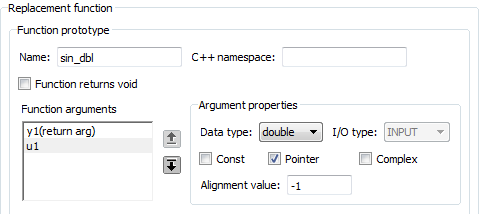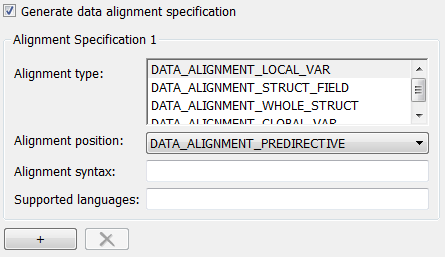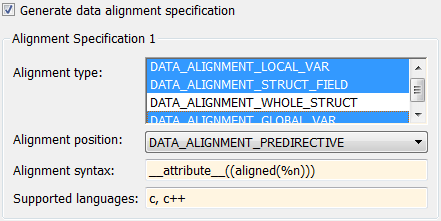Data Alignment for Code Replacement
When using code replacement, if your implementation function requires aligned data to optimize application performance, align the arguments passed to the function by using the code replacement entry.
To perform data alignment without replacing the generated function, see Optimize Performance of Memory Access by Using Data Alignment.
Code Replacement Data Alignment
You can take advantage of function implementations that require aligned data to optimize application performance. To configure data alignment for a function implementation:
Specify the data alignment requirements in a code replacement entry. Specify alignment separately for each implementation function argument or collectively for all function arguments. See Specify Data Alignment Requirements for Function Arguments.
If the scope of the data is imported, you must also specify the alignment requirements on the data object so that the code replacement entry can match the data for replacement.
Specify the data alignment capabilities and syntax for one or more compilers. Include the alignment specifications in a library registration entry in the
rtwTargetInfo.mfile. See Provide Data Alignment Specifications for Compilers.Register the library containing the table entry and alignment specification object.
Configure the code generator to use the code replacement library.
Generate code and observe the results.
For examples, see Programmatically Develop a Code Replacement Library Using Data Alignment and the “Data Alignment for Function Implementations” section of the Optimize Generated Code by Developing and Using Code Replacement Libraries - Simulink example page.
Specify Data Alignment Requirements for Function Arguments
To specify the data alignment requirement for an argument in a code replacement entry:
If you are defining a replacement function in a code replacement table registration file, create an argument descriptor object (
RTW.ArgumentDescriptor). Use the objectAlignmentBoundaryproperty to specify the required alignment boundary and assign the object to the argumentDescriptorproperty.If you are defining a replacement function using the Code Replacement Tool, on the Mapping Information tab, in the Argument properties section for the replacement function, enter a value for the Alignment value parameter.

The AlignmentBoundary property (or Alignment
value parameter) specifies the alignment boundary for data
passed to a function argument, in number of bytes. The AlignmentBoundary property
is valid only for addressable objects, including matrix and pointer
arguments. It is not applicable for value arguments. Valid values
are:
-1(default) — If the data is aSimulink.Bus,Simulink.Signal, orSimulink.Parameterobject, specifies that the code generator determines an optimal alignment based on usage. Otherwise, specifies that there is not an alignment requirement for this argument.Positive integer that is a power of 2 — Specifies number of bytes in the boundary. The starting memory address for the data allocated for the function argument is a multiple of the specified value. If you specify an alignment boundary that is less than the natural alignment of the argument data type, the alignment directive is emitted in the generated code. However, the target compiler ignores the directive.
The following code specifies the AlignmentBoundary for
an argument as 16 bytes.
hLib = RTW.TflTable; entry = RTW.TflCOperationEntry; arg = getTflArgFromString(hLib, 'u1','single*'); desc = RTW.ArgumentDescriptor; desc.AlignmentBoundary = 16; arg.Descriptor = desc; entry.Implementation.addArgument(arg);
The equivalent alignment boundary specification in the Code Replacement Tool dialog box is in this figure.

Specify Alignment for Imported Data
If the scope of the data is imported, you must also specify the alignment requirements on the data object so that the code replacement entry can match the data for replacement. Specifying the alignment on the data object indicates to the code generator that the external code that defines the data performs the alignment.
Specify the alignment boundary by using the Alignment property of
the Simulink.Bus, Simulink.Signal, or Simulink.Parameter object. For more
information, see Specify Data Alignment Requirements for Data Objects.
Provide Data Alignment Specifications for Compilers
To support data alignment in generated code, describe the data alignment capabilities and syntax for your compilers in the code replacement library registration. Provide one or more alignment specifications for each compiler in a library registry entry.
If you are defining a code replacement library registration entry in a
rtwTargetInfo.mcustomization file, add one or moreAlignmentSpecificationobjects to anRTW.DataAlignmentobject. Attach theRTW.DataAlignmentobject to theTargetCharacteristicsobject of the registry entry.An example of a data alignment specification for the GCC compiler follows.
da = RTW.DataAlignment; as = RTW.AlignmentSpecification; as.AlignmentType = {'DATA_ALIGNMENT_LOCAL_VAR', ... 'DATA_ALIGNMENT_STRUCT_FIELD', ... 'DATA_ALIGNMENT_GLOBAL_VAR'}; as.AlignmentSyntaxTemplate = '__attribute__((aligned(%n)))'; as.AlignmentPosition = 'DATA_ALIGNMENT_PREDIRECTIVE'; as.SupportedLanguages = {'c', 'c++'}; da.addAlignmentSpecification(as); tc = RTW.TargetCharacteristics; tc.DataAlignment = da;The
RTW.DataAlignmentobject also has the propertyDefaultMallocAlignment, which specifies the default alignment boundary, in bytes, that the compiler uses for dynamically allocated memory. If the code generator uses dynamic memory allocation for a data object involved in a code replacement, this value determines if the memory satisfies the alignment requirement of the replacement. If not, the code generator does not use the replacement. The default value forDefaultMallocAlignmentis-1, indicating that the default alignment boundary used for dynamically allocated memory is unknown. In this case, the code generator uses the natural alignment of the data type to determine whether to allow a replacement.Additionally, you can specify the alignment boundary for complex types by using the
addComplexTypeAlignmentfunction.If you are generating a customization file function using the Code Replacement Tool, specify settings for these parameters for each compiler.

Click the plus (+) symbol to add additional compiler specifications.
Here is the specification for the GCC compiler in the Generate registration file dialog box of the Code Replacement Tool.

For each data alignment specification, provide this information.
|
|
Dialog Box Parameter |
Description |
|---|---|---|
|
|
Alignment type | Cell array of predefined enumerated strings specifying the types of alignment this specification supports.
Each alignment specification
must specify at least
|
|
|
Alignment position | Predefined enumerated string
specifying the position in which you must place
the compiler alignment directive for the alignment
type
For alignment types other
than
|
|
|
Alignment syntax | Specify the alignment directive string that the compiler supports. The string is registered as a syntax template that has placeholders in it. These placeholders are supported:
For example, for the gcc
compiler, you can specify
|
|
|
Supported languages | Cell array specifying the languages
to which this alignment specification applies,
among |
Interactively Develop a Code Replacement Library Using Data Alignment
Open the Code Replacement Tool (crtool), from the MATLAB command line with this command:
>>crtool
Create a table.
From the toolstrip of the Code Replacement tool, click New > Table.
In the right pane, name the table
data_alignment. Click Apply.
Create an entry. Click New > Entry > Math Operation Entry.
Create entry parameters. In the Operation drop-down list, select
Multiply.Create the conceptual representation. The conceptual representation describes the signature of the function that you want to replace. In the Conceptual function subsection of the crtool, add the arguments
y1,u1, andu2and specify these parameters for each argument:Data Type —
singleArgument type —
MatrixLower range —
[4 4]Upper range —
[4 4]
Create the implementation representation. The implementation representation describes the signature of the optimization function. Select the Function returns void parameter.
Specify the Name for the replacement function as
matrix_mul_4x4.Specify the alignment boundaries for the implementation arguments. For the implementation arguments
y1,u1, andu2, specify these parameters:Data Type —
singlePointer — on
Alignment value —
16
Specify build information. Click the Build Information tab to open the build requirements pane. Specify the files (source, header, object) that the code generator requires for code replacement. For this example, you do not need to specify build information.
Validate and save the table. Click the Mapping Information tab and verify the parameters are set as shown. Click Apply, then click Validate entry. On the toolstrip, click Save and save the table.

Register a code replacement library. Registration creates a library composed of the tables that you specify. Click Generate Registration File. In the Generate registration file dialog box, specify these parameter settings:
Registry name —
CRL for Data AlignmentTable list —
data_alignmentBase CRL —
NoneTarget HW device —
*Description —
Example code replacement libraryGenerate data alignment specification — on
In the Alignment Specification 1 section, add this alignment information:
Alignment type — select
DATA_ALIGNMENT_LOCAL_VAR,DATA_ALIGNMENT_STRUCT_FIELD, andDATA_ALIGNMENT_GLOBAL_VAR.Alignment position —
DATA_ALIGNMENT_PREDIRECTIVEAlignment syntax —
__attribute__((aligned(%n)))Supported languages —
c, c++

Click OK. To use your code replacement library, refresh your current MATLAB session with this command:
>>sl_refresh_customizations
Verify the code replacement library. From the MATLAB command line, open the library by using the Code Replacement Viewer and verify that the table and entry are correctly specified. For more information, see Verify Code Replacement Library. Configure your model to use the code replacement library, generate code, and verify that replacement occurs as expected. If unexpected behavior occurs, examine the hit and miss logs to troubleshoot the issues.
Programmatically Develop a Code Replacement Library Using Data Alignment
A simple example of the complete workflow for data alignment specified for code replacement is:
Create and save the following code replacement table definition file,
crl_table_mmul_4x4_single_align.m. This table defines a replacement entry for the * (multiplication) operator, thesingledata type, and input dimensions[4,4]. The entry also specifies a data alignment boundary of 16 bytes for each replacement function argument. The entry expresses the requirement that the starting memory address for the data allocated for the function arguments during code generation is a multiple of 16.function hLib = crl_table_mmul_4x4_single_align %CRL_TABLE_MMUL_4x4_SINGLE_ALIGN - Describe matrix operator entry with data alignment hLib = RTW.TflTable; entry = RTW.TflCOperationEntry; setTflCOperationEntryParameters(entry, ... 'Key', 'RTW_OP_MUL', ... 'Priority', 90, ... 'ImplementationName', 'matrix_mul_4x4_s'); % conceptual arguments createAndAddConceptualArg(entry, 'RTW.TflArgMatrix',... 'Name', 'y1', ... 'IOType', 'RTW_IO_OUTPUT', ... 'BaseType', 'single', ... 'DimRange', [4 4]); createAndAddConceptualArg(entry, 'RTW.TflArgMatrix',... 'Name', 'u1', ... 'BaseType', 'single', ... 'DimRange', [4 4]); createAndAddConceptualArg(entry, 'RTW.TflArgMatrix',... 'Name', 'u2', ... 'BaseType', 'single', ... 'DimRange', [4 4]); % implementation arguments arg = getTflArgFromString(hLib, 'y2', 'void'); arg.IOType = 'RTW_IO_OUTPUT'; entry.Implementation.setReturn(arg); arg = getTflArgFromString(hLib, 'y1','single*'); arg.IOType = 'RTW_IO_OUTPUT'; desc = RTW.ArgumentDescriptor; desc.AlignmentBoundary = 16; arg.Descriptor = desc; entry.Implementation.addArgument(arg); arg = getTflArgFromString(hLib, 'u1','single*'); desc = RTW.ArgumentDescriptor; desc.AlignmentBoundary = 16; arg.Descriptor = desc; entry.Implementation.addArgument(arg); arg = getTflArgFromString(hLib, 'u2','single*'); desc = RTW.ArgumentDescriptor; desc.AlignmentBoundary = 16; arg.Descriptor = desc; entry.Implementation.addArgument(arg); hLib.addEntry(entry);
Create and save the following registration file,
rtwTargetInfo.m. If you want to compile the code generated in this example, first modify theAlignmentSyntaxTemplateproperty for the compiler that you use. For example, for the MSVC compiler, replace the gcc template specification__attribute__((aligned(%n)))with__declspec(align(%n)).function rtwTargetInfo(cm) % rtwTargetInfo function to register a code replacement library (CRL) % for use with code generation % Register the CRL defined in local function locCrlRegFcn cm.registerTargetInfo(@locCrlRegFcn); end % End of RTWTARGETINFO % Local function to define a CRL containing crl_table_mmul_4x4_single_align function thisCrl = locCrlRegFcn % create an alignment specification object, assume gcc as = RTW.AlignmentSpecification; as.AlignmentType = {'DATA_ALIGNMENT_LOCAL_VAR', ... 'DATA_ALIGNMENT_GLOBAL_VAR', ... 'DATA_ALIGNMENT_STRUCT_FIELD'}; as.AlignmentSyntaxTemplate = '__attribute__((aligned(%n)))'; as.SupportedLanguages={'c', 'c++'}; % add the alignment specification object da = RTW.DataAlignment; da.addAlignmentSpecification(as); % add the data alignment object to target characteristics tc = RTW.TargetCharacteristics; tc.DataAlignment = da; % Instantiate a CRL registry entry thisCrl = RTW.TflRegistry; % Define the CRL properties thisCrl.Name = 'Data Alignment Example'; thisCrl.Description = 'Example of replacement with data alignment'; thisCrl.TableList = {'crl_table_mmul_4x4_single_align'}; thisCrl.TargetCharacteristics = tc; end % End of LOCCRLREGFCN
To register your library with code generator without having to restart MATLAB®, enter this command:
RTW.TargetRegistry.getInstance('reset');Configure the code generator to use your code replacement library.
Generate code and a code generation report.
Review the code replacements. For example, check whether a multiplication operation is replaced with a
matrix_mul_4x4_sfunction call. Inmmalign.h, check whether the gcc alignment directive__attribute__((aligned(16)))is generated to align the function variables.